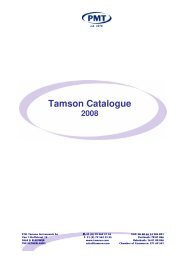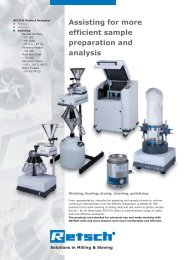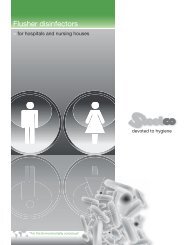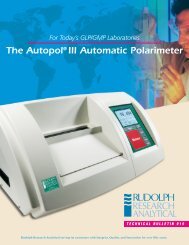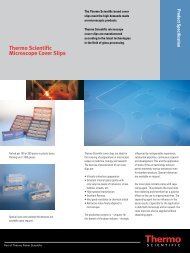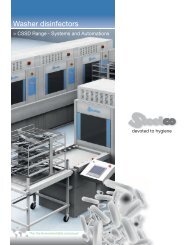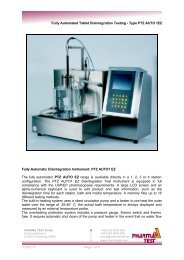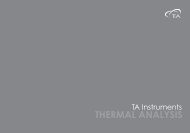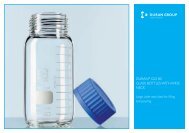KERN FIS Fully encapsulated stainless steel scale ... - Labochema
KERN FIS Fully encapsulated stainless steel scale ... - Labochema
KERN FIS Fully encapsulated stainless steel scale ... - Labochema
You also want an ePaper? Increase the reach of your titles
YUMPU automatically turns print PDFs into web optimized ePapers that Google loves.
<strong>KERN</strong> Glossary<br />
<strong>KERN</strong> A–Z<br />
Readout d:<br />
Smallest readable weight increment on a digital display.<br />
Recalibration:<br />
periodic checking of the precision of measurement equipment/checking<br />
equipment (e.g. balances/weights) to keep<br />
control over accuracy, ➔ Control of measuring equipment.<br />
Reference weight (when piece counting):<br />
representative piece weight with piece counting of same<br />
pieces. Ascertained by taking the average of several pieces.<br />
The reference quantity of pieces is the number of<br />
pieces selected to determine the reference weight. Mostly<br />
between 10 and 50 pieces ➔ Piece counting of single<br />
pieces.<br />
Reproducibility (standard deviation):<br />
the measure of conformity in repeat weighing (e.g. balances)<br />
subject to the same conditions. Mostly 1 d or less.<br />
Quality feature.<br />
Semi-micro balance:<br />
analytical balance with a readout d = 0.01 mg.<br />
Taring, automatic:<br />
when the tare pan is put in place the balance immediately<br />
displays zero. Saves time.<br />
Taring, subtractive:<br />
the disposable weighing range of a balance is reduced by<br />
the value of the tare load. E.G. weighing range of a<br />
balance Max 6000 g, Tare (container) 470 g, disposable<br />
weighing range 5530 g.<br />
Test weight external (previously calibration weight):<br />
for adjusting or checking the balance accuracy ➔ Ad justing<br />
the weighing range. The external test weight can be DKD<br />
calibrated at any time, even afterwards, see page 91.<br />
Test weight internal:<br />
like test weight external, but installed in the balance and<br />
powered.<br />
Test weights: classes of accuracy E, F, M and their<br />
general relation to the types of balances:<br />
E2 the most accurate test weights for high resolution analy -<br />
tical balances of verification category I , ≥ 100.000 e<br />
F1 precision weights for analytical balances/precision<br />
balances of verification category I / II , up to<br />
100,000 e<br />
F2 test weights for precision balances<br />
of verification category II , up to 30,000 e<br />
M1 precision weights for industrial and trade<br />
balances of verification category III , up to 10,000 e<br />
more closely defined rules to determine the correct test<br />
weight and example of application, see page 92.<br />
Tolerance checks:<br />
See ➔ Weighing with tolerance ranges.<br />
Totalizing:<br />
various individual weighing are added automatically to<br />
aggregate, e.g. all individual weighing of a batch.<br />
Traceability to the National Standard:<br />
ISO 9000 ff requires the correctness of all checking equipment<br />
in accordance to the defined tolerance. Thereby incorrect<br />
measurement is prevented<br />
Uncertainty of measurement of a balance<br />
(= standard deviation):<br />
determined for each balance according to a precisely given<br />
test method and documented in the ➔ Calibration<br />
certificate. It depends on various factors both internal and<br />
external. With increasing weight the uncertainty of<br />
measure ment rises, see page 90<br />
Verifiable/non-verifiable balances:<br />
metrological nearly identical. For verifiable balances certain<br />
details are regulated by law, e.g. software changes<br />
and additional markings.<br />
Verification categories of balances:<br />
I analytical balances (precision balances), II precision<br />
balances, III industrial <strong>scale</strong>s (commercial <strong>scale</strong>s).<br />
Verifying:<br />
only balances capable of being verified can be verified<br />
officially. These balances are marked with M. Verifiability in<br />
business is specified by the state. It serves as consumer<br />
security<br />
Verification:<br />
according to the EU directive 90/ 384/ EWG balances<br />
must be verified if they are used as follows:<br />
a) in commercial trade when the price of a commodity is<br />
determined by weighing.<br />
b) in the manufacture of pharmaceuticals and analysis in<br />
pharmaceutical and medical laboratories.<br />
c) for official purpose.<br />
d) in the production of prepackaging.<br />
Every balance is tested by the metrological service and<br />
stamped with a verification mark. Its accuracy within the<br />
framework of permissible standard tolerances is thereby<br />
confirmed. EU verification applies to all member states of<br />
the EU.<br />
Verification of a balance with adjusting program<br />
CAL:<br />
the adjusting program is sealed with an official mark after<br />
the verification. Thus the verification is only valid for the<br />
specific location of use. ➔ Earth’s gravitational force.<br />
For the preparation of verification it is therefore necessary<br />
to advise the location of use and post code. See individual<br />
model details for the information as to whether verification<br />
can be carried out in the factory or at the location of use<br />
Verification validity for balances:<br />
Generally 2 years for all verification categories, for control<br />
balances generally 1 year, after expiration the balance has<br />
to be reverified.<br />
Verification of a balance with automatic internal<br />
adjusting CAL INT:<br />
the above restrictions in respect of the location of use do<br />
not apply, because the automatic internal adjusting works<br />
also after the verification, therefore it is not sealed. In this<br />
case the verification does not depend on the location.<br />
Verification value e:<br />
measure of the verification tolerance, depending on balance,<br />
mostly between<br />
1 d and 10 d, ➔ Readout.<br />
Weighing range MAX:<br />
is the working range of the balance. The balance can be<br />
loaded up to the specified upper limit<br />
Weighing with tolerance ranges:<br />
the lower and upper limiting values are programmed<br />
individually. Input is possible in gram, pieces or %. With<br />
tolerance checks such as dosing, portioning or sorting the<br />
balance displays the value over or under the limits.<br />
97




